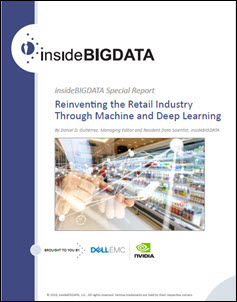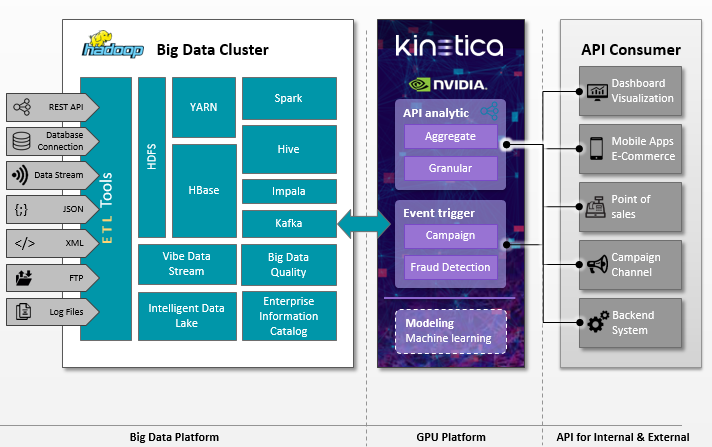 The insideBIGDATA Special Report: Reinventing the Retail Industry through Machine and Deep Learning white paper explores how AI, machine learning and deep learning are transforming the retail industry in many positive directions including:
The insideBIGDATA Special Report: Reinventing the Retail Industry through Machine and Deep Learning white paper explores how AI, machine learning and deep learning are transforming the retail industry in many positive directions including:
- Inventory and supply chain management
- Analysis of customer buying patterns
- Analyzing traffic patterns
- Providing assortment planning
- Performing retail analytics at scale
- Fighting cyberfraud
Retail Analytics at Scale
The growing challenge confronted by the retail industry is that, with ever larger data sets, the database and visualization tools that once served them well are no longer up to the task. Insights needed in milliseconds often take minutes, or even hours. At that slow pace, the tendency is to accept what’s available versus what’s needed. This capitulation is a prescription for failure. The modern retailer needs to process large amounts of retail data in real time, in order to capitalize on insights discovered in their retail analytics.
Many forward-leaning retailers are now working with GPU-accelerated analytics databases like those from Kinetica and MapD to seamlessly harness the power of massively parallel GPUs to deliver real-time interactive analytics at scale. In general, these technology solutions are in-memory databases with parallel processing using GPUs. A lot of the emergent machine learning algorithms combined with big data require a greater density of computing. GPUs have as many as 4000 cores as opposed to traditional CPUs having 16 to 32 per socket.
In the retail space, some players use recommendation engines that apply deep learning at scale. For example, say a customer is moving about in a store with a basket of goods and the individual items incorporate RFIDs. With use of an application the retailer might make additional purchase recommendations based on the basket composition as the customer is heading toward checkout. This is based on a deep model that is neural network based, combined with training using a framework like TensorFlow. In order to run this level of processing, there’s a very large data set consisting of millions of transactions.
Accelerated analytics using GPU databases enables a 360-degree customer profile, offering a multi-dimensional set of customer attributes to describe their behavior: facial recognition, customer profile (age, marital status, income range, etc.), purchase behavior, visit behavior, merchants visited at physical locations, and lifestyle. These attributes can be achieved using tools like TensorFlow or Keras for facial recognition, clustering for basket fingerprint, and clustering for socio-economic status. Such actionable insights allow retailers to engage customers with a new and better experience.
A GPU-tuned database and visualization layer takes advantage of the most powerful compute engines in the world to deliver lightning fast analytics to some of the most powerful brands and retailers on the planet. Take the example of one of the world’s largest sporting goods brands.
A GPU database is used to determine, in real-time, how to adjust inventory levels to better manage micro-segments within their customer population that had previously gone undetected until days or weeks after the opportunity had passed. Now, armed with analytics at scale, this brand can easily outpace their competition, extract more from their channel partners, analyze demographic visualizations, and add incremental growth to a competitive industry.

GPU-accelerated analytics database architecture courtesy of Kinetica
Deep Learning for Maintaining Privacy and Combating Cyberfraud
 We’re also seeing deep learning being used by the retail ecosystem to protect the privacy and security of consumer data while generating insights. Dell EMC is working with MasterCard and other organizations to combat cyberfraud.
We’re also seeing deep learning being used by the retail ecosystem to protect the privacy and security of consumer data while generating insights. Dell EMC is working with MasterCard and other organizations to combat cyberfraud.
The company also is working closely with partners like Cloudera and NVIDIA to integrate Dell EMC’s platform and make an organization like MasterCard able to capitalize on the convergence between tools like Hadoop and the process of machine learning to provide the benefits of data protection to organizations of all types.
Security is arguably one of the most important aspects of big data. With such sensitive material as customers’ social security numbers and credit cards flowing throughout the cloud, innovative means of achieving protection and deep threat analysis are essential components for any well-run retail organization.
Article Series
In a series of articles over the next few weeks we will explore these topics:
- Introduction, Intelligent retail inventory management
- Analyzing buying patterns, analyzing traffic patterns, assortment planning
- Retail analytics at scale, Deep learning for maintaining privacy and combating fraud
- Dell EMC machine learning and deep learning ready bundles, summary
If you prefer, the complete insideBIGDATA Special Report: Reinventing the Retail Industry through Machine and Deep Learning is available for download in PDF from the insideBIGDATA White Paper Library, courtesy of Dell EMC and NVIDIA.




Speak Your Mind